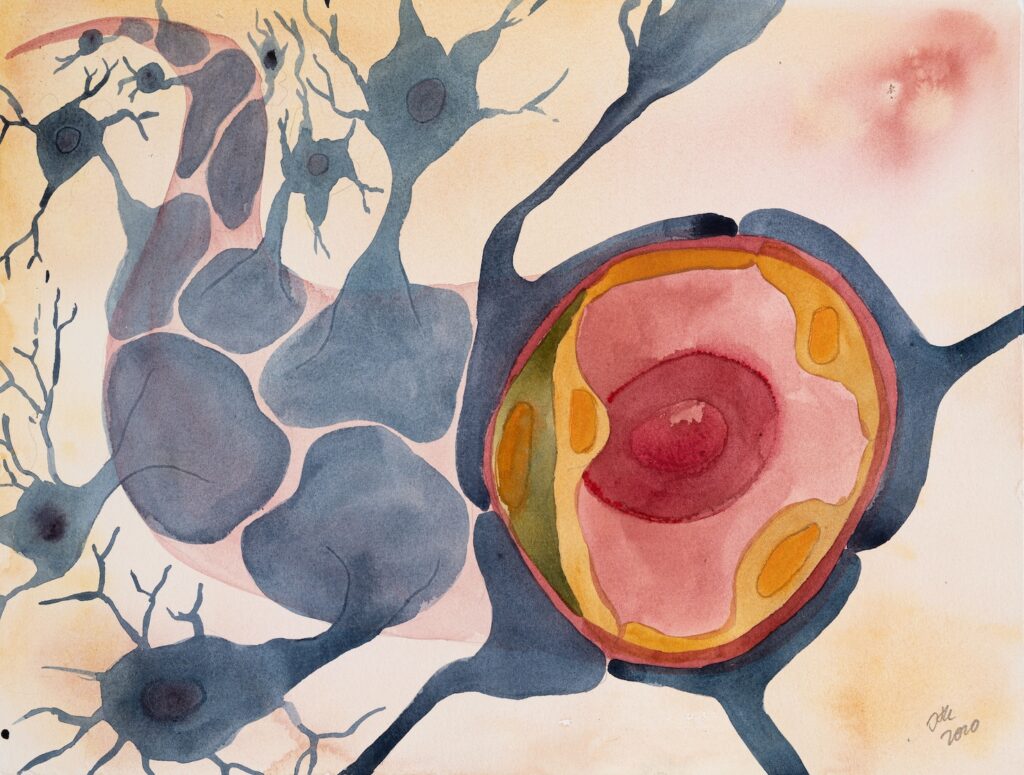Blood brain barrier

Biorelevant culture of blood-brain barrier cells on Biolaminin substrates
Blood-brain barrier structure and function
Endothelial cells lining small brain capillaries separate the blood from the brain parenchyma. They function like a barrier, the blood-brain barrier (BBB), due to tight junctions and different solute carriers and efflux transporters. The endothelial cells are covered by pericytes embedded in the basement membrane, and pericytes and endothelium are in turn completely covered by a layer of astrocyte endfeet. The brain capillary endothelial cells, pericytes, astrocytes, and associated basement membrane is called the neurovascular unit. There is a great interest for the development of an ideal in vitro model reflecting authentic BBB properties and function, allowing both mechanistic studies and rapid screening of permeable CNS drug candidates.
Biolaminin for each cell type relevant to the neurovascular unit
- Endothelial cells express laminin 411 and laminin 511 (Hallman, 2005)
- Pericyte differentiation is regulated by laminin 111 and laminin 211 (Yao, 2014)
- Astrocytes express laminin isoforms 111, 211 and 521 (Sixt, 2001)
Laminins relevant for BBB integrity
Strickland group (Yao, 2014) demonstrate that laminin 111 and laminin 211 are essential for the maintenance of the BBB integrity by regulating the differentiation of pericytes. In support, Menezes and colleagues (2014) report that mice lacking alfa2 has a defective BBB. In another article, the authors show that laminin 511 plays a key role in the maintenance and repair of BBB after hypoxic injury and inflammation (Kangwantas, 2016).
Succeed with your application
-
Instructions 001: Coating with Biolaminin substrates
Protocol and concentration calculations for coating cultureware with Biolaminin
Open pdf -
Application note 016: Biosilk 3D biomaterial for organoid culture
Features and supporting data for Biosilk in 3D cell culture
Open pdf -
Other24/05/2021
FAQ
Frequently Asked Questions
Biolaminin Key Advantages
Brain endothelial cells, pericytes, and astrocytes all produce laminins. Laminin 111 and laminin 211 are essential for the maintenance of the BBB integrity. Laminin 511 plays a key role in the maintenance and repair of BBB after hypoxic injury and inflammation.
All our matrices are chemically defined and animal origin-free, which makes them ideal substrates for each level of the scientific process – from basic research to clinical applications.
Our products have consistent composition and quality. This enables minimized variability between experiments and uniform pluripotency gene expression profiles between different cell lines.
Numerous scientists have found our products and finally succeeded in their specific stem cell application. The power of full-length laminins incorporated into various cell systems is well documented in scientific articles and clinical trials.
Recommended products
-

Biolaminin 111 LN (LN111)
Human recombinant laminin 111
Biolaminin 111 is commonly used as a general attachment protein for many cell types in vitro.View product -

Biolaminin 211 LN (LN211)
Human recombinant laminin 211
Biolaminin 211 supports the growth, survival, and differentiation of a wide range of tissue-specific cell types, including motor neurons, cardiac cells, and skeletal muscle cells.View product -

Biolaminin 511 LN (LN511)
Human recombinant laminin 511
Biolaminin 511 is the natural laminin for mouse embryonic stem cells and allows sustained pluripotency without the need to use feeder cells or differentiation inhibitors like LIF.View product -

Biolaminin 521 LN (LN521)
Human recombinant laminin 521
Biolaminin 521 LN is the natural laminin for pluripotent stem cells and therefore reliably facilitates self-renewal of human ES and iPS cells in a chemically defined, feeder-free and animal origin-free stem cell culture system. LN521 is animal origin-free to the primary level.View product

Talk to our team for customized support
We are here to help you in your journey.